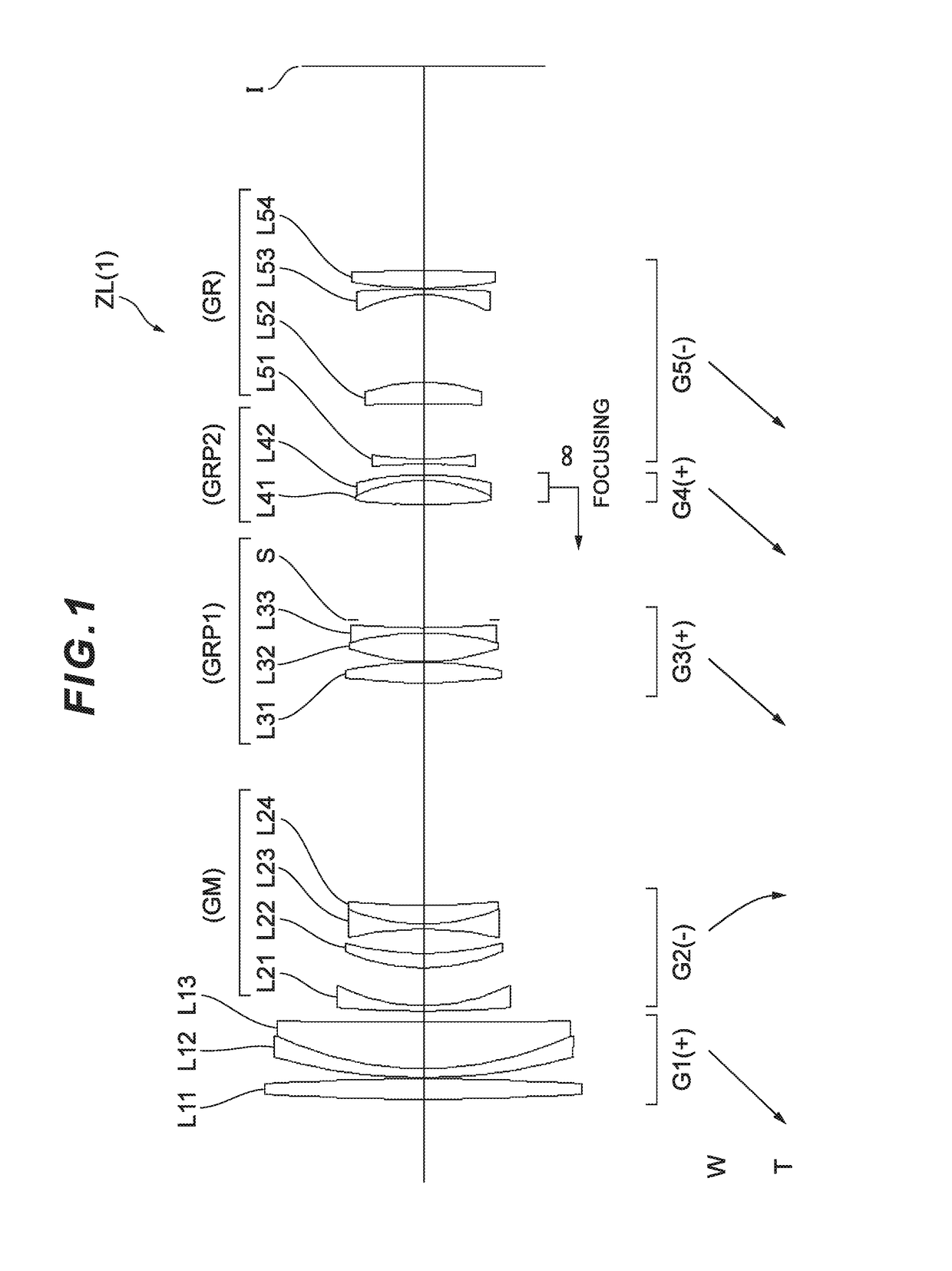Zoom optical system, optical apparatus and method for manufacturing the zoom optical system
a technology of optical system and zoom, applied in the field of zoom optical system, can solve the problem of insufficient optical performance of such a conventional zoom optical system
- Summary
- Abstract
- Description
- Claims
- Application Information
AI Technical Summary
Benefits of technology
Problems solved by technology
Method used
Image
Examples
example 1
[0103]Example 1 is described with reference to FIG. 1, FIGS. 2A and 2B, FIG. 3, FIGS. 4A and 4B, and FIGS. 5A-5C and Table 1. FIG. 1 is a diagram illustrating a lens configuration of a zoom optical system according to Example 1 of the present embodiment. The zoom optical system ZL(1) according to Example 1 consists of, in order from an object: a first lens group G1 having positive refractive power; a second lens group G2 having negative refractive power; a third lens group G3 having positive refractive power; an aperture stop S; a fourth lens group G4 having positive refractive power; and a fifth lens group G5 having negative refractive power. The first to the fifth lens groups G1 to G5 each move in a direction indicated by an arrow in FIG. 1 upon zooming from a wide angle end state (W) to a telephoto end state (T). In this Example, the intermediate group GM includes the second lens group G2, the intermediate side lens group GRP1 includes the third lens group G3 and the aperture sto...
example 2
[0115]Example 2 is described with reference to FIG. 6, FIGS. 7A and 7B, FIG. 8, FIGS. 9A and 9B, and FIGS. 10A-10C and Table 2. FIG. 6 is a diagram illustrating a lens configuration of a zoom optical system according to Example 2 of the present embodiment. The zoom optical system ZL(2) according to Example 2 consists of, in order from an object: a first lens group G1 having positive refractive power; a second lens group G2 having negative refractive power; a third lens group G3 having positive refractive power; an aperture stop S; a fourth lens group G4 having positive refractive power; and a fifth lens group G5 having negative refractive power. The first to the fifth lens groups G1 to G5 each move in a direction indicated by an arrow in FIG. 6 upon zooming from a wide angle end state (W) to a telephoto end state (T). In this Example, the intermediate group GM includes the second lens group G2, the intermediate side lens group GRP1 includes the third lens group G3 and the aperture s...
example 3
[0126]Example 3 is described with reference to FIG. 11, FIGS. 12A and 12B, FIG. 13, FIGS. 14A and 14B, and FIGS. 15A-15C and Table 3. FIG. 11 is a diagram illustrating a lens configuration of a zoom optical system according to Example 3 of the present embodiment. The zoom optical system ZL(3) according to Example 3 consists of, in order from an object: a first lens group G1 having positive refractive power; a second lens group G2 having negative refractive power; a third lens group G3 having positive refractive power; an aperture stop S; a fourth lens group G4 having positive refractive power; and a fifth lens group G5 having negative refractive power. The first to the fifth lens groups G1 to G5 each move in a direction indicated by an arrow in FIG. 11 upon zooming from a wide angle end state (W) to a telephoto end state (T). In this Example, the intermediate group GM includes the second lens group G2, the intermediate side lens group GRP1 includes the third lens group G3 and the ap...
PUM
 Login to View More
Login to View More Abstract
Description
Claims
Application Information
 Login to View More
Login to View More - R&D
- Intellectual Property
- Life Sciences
- Materials
- Tech Scout
- Unparalleled Data Quality
- Higher Quality Content
- 60% Fewer Hallucinations
Browse by: Latest US Patents, China's latest patents, Technical Efficacy Thesaurus, Application Domain, Technology Topic, Popular Technical Reports.
© 2025 PatSnap. All rights reserved.Legal|Privacy policy|Modern Slavery Act Transparency Statement|Sitemap|About US| Contact US: help@patsnap.com



